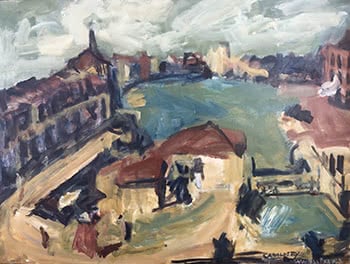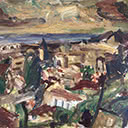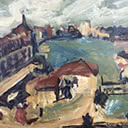Canaletto
90 x 121 cm
PROVENANCE
Purchased from Aberhart North Gallery, 1987
EXHIBITED
M.T. Woollaston, An exhibition of oil paintings to mark the occasion of the artist's birthday, Cat. no. 8
Aberhart North Gallery 9 - 28 April 1990 Note: The present owner lent the work for above exhibition
Canaletto bears the hallmarks of a typical Woollaston painting: cool, crystalline blues meet with earthy colours; a cloudy sky balances out a composition which is skilful in its treatment of dense, complex perspective. But it leaves us with one question - where exactly is this scene set? The inscription Canaletto, which could be construed as a playful second signature, is our best clue to the artist's intentions for this intriguing and energetic composition.
The 18th century painter Giovanni Canal, known as Canaletto, was celebrated for his painted views of Italy, in particular of Venice. In London's Wallace Collection, an entire room is devoted to his vedute paintings. They are striking in their jewel-like precision and mathematically precise views of city life and architecture. In his paintings, Canaletto would manipulate the city's layout in order to construct the most visually pleasing composition - shifting buildings and entire topographical features, reimagining each view to fit with his own vision. In his lifetime he enjoyed fame and commercial demand, but was also criticised by some for his city portraits which they judged as unfashionably romantic.
Knowing this about Canaletto makes it interesting that Woollaston, a New Zealand artist who was influenced more by the plein air impressionists than anyone in the 18th century European style, decided to invoke his name. One possibility is that he was taking the Venetian's name in vain in this work, and offering to improve on his style. Here's a new imaginary view of Venice, says Woollaston, painted using the senses; appropriately muddied and brown. In this case, the joke is of course that the resulting work is far from a Canaletto. But Woollaston's approach may not necessarily have been so cynical. It's possible he was also acknowledging Canaletto's artistic imagination, and his willingness to manipulate perspective. In that sense, both artists were united in their cause.





